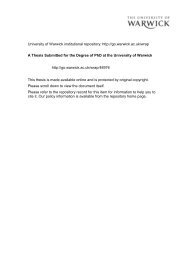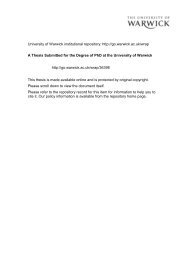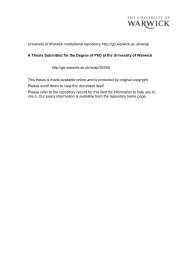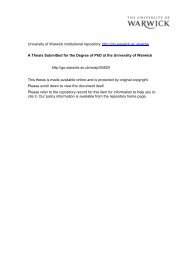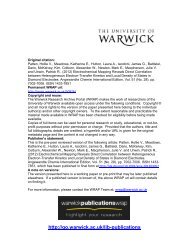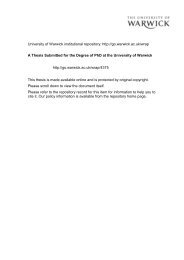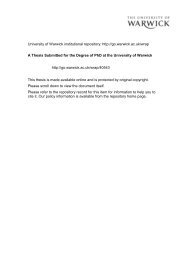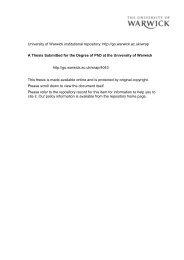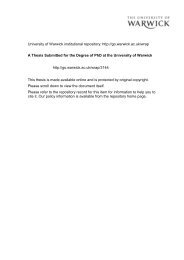Download (13Mb) - WRAP: Warwick Research Archive Portal ...
Download (13Mb) - WRAP: Warwick Research Archive Portal ...
Download (13Mb) - WRAP: Warwick Research Archive Portal ...
Create successful ePaper yourself
Turn your PDF publications into a flip-book with our unique Google optimized e-Paper software.
the text in her creation of her own textual space makes it an attractive genre for the<br />
expression of this gender-based anxiety. Here there is a suggestion of difference<br />
within general theories of postmodern angst. It is possible to distinguish between the<br />
postmodernist tendency of the fantastic to question the control of the narrator 104 and<br />
the more deeply ingrained female mistrust ofwhat her Imaginary itselfproduces.<br />
Pierre Machery's comment that 'the recognition of the area ofshadow in or<br />
around the work is the initial moment of criticism'l'" (my italics) seems particularly<br />
pertinent to the literary notion of the fantastic. The heightened emphasis on the<br />
interpretative function triggered by the large area of shadow into which many<br />
fantastic texts descend, underlines, and at the same time, often frustrates, the reader's<br />
role as critic and interpreter of literature. In one sense this could be interpreted a re<br />
valuation of the work of art itself. To this effect I feel that much fantastic narrative<br />
belongs to that category of work described by Sontag as being created as 'a flight<br />
from interpretation' .106 It functions to return the reader's attention upon the<br />
indivisibility of meaning from the text itself. As Lichtenberg's knife and Kafka's<br />
Odradek suggest: perhaps those literary signifiers that remain with us are the most<br />
fantastic ones.<br />
The hermeneutic process foregrounded by the fantastic can also be read in the<br />
light of Ragland-Sullivan's words on a Lacanian poetics which would 'claim that the<br />
purpose of reading and writing literary texts is to evoke a shadow meaning network<br />
whose structures, messages and effects control our lives, but whose truths are<br />
evasive.,107 This double function of the fantastic to focus the reader on the literary<br />
text, only to bring himlher back to interrogate his/her relationship to reality is further<br />
heightened by the use of transtextuality and self-reflexivity. For women writers I<br />
intend to show how it serves the double function ofretreat from their reading position<br />
as oversignified objects and tentative steps towards tracing the shadow of a reality<br />
always beyond their reach.<br />
(eds), p.239.<br />
Marina Polacco emphasizes the close links between non-realist modes of<br />
104 See Deborah Harter, 'If [...] the literary text might be thought of as a recording of the "mastery and<br />
control" of its image content - of the sedimentary of its images and their transformation from the<br />
Imaginary into the Symbolic - fantastic narrative would seem to mark the misdirection ofthis process. I<br />
(£.69)<br />
I 5 Pierre Macherey, A Theory ofLiterary Production, trans. by Geoffrey Paul (London: Routledge and<br />
Kegan Paul, 1978, first pub!. 1966), p.82.<br />
106 Eponymous essay in Against Interpretation, written in 1964 (London: Vintage, 1994), p. 10.<br />
107 cit. by Schwenger, p.35.<br />
37




